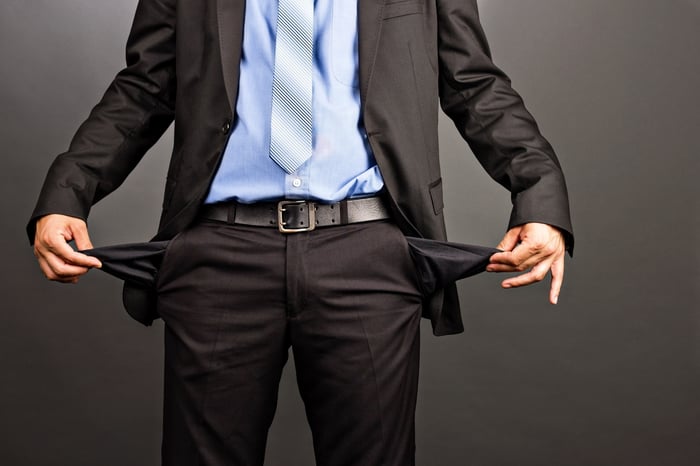One of the strange realities of life is the fact that you can live much more cheaply when you're rich than you can when you're poor. When you have money, a lot of the costs people without money face either go away entirely or become substantially cheaper and easier to manage.
You can't change that reality -- but what you can do is recognize it. Once you do, you can take steps to improve your own financial situation so that you can benefit from many of those advantages. That way, you can get the money you bring in to last longer and help you build wealth of your own. With that in mind, here are five ways the rich can live cheaper than you, and ideas to help you close that gap.

Image source: Getty Images.
1. Lower costs to borrow
Very few people can get away without borrowing any money at all. What people with money can do, however, is match their borrowing to only those times and needs where the cost to borrow is low. And even then, when they borrow, they can often qualify for better rates and terms than those without money can.
The reason is straightforward -- lenders need a reason to believe they will be paid back, on time and in full, in order to lend out their money. The less risk a borrower represents, the higher the lender's confidence is that it'll be paid back, and the lower the rate the lender needs to charge to make the loan. All else equal, a person with more cash looks capable of being able to put that cash toward paying back a loan, and therefore looks like a lower-risk borrower.
You can take steps to make yourself a more attractive borrower to start to qualify for those better rates. First, recognize that if you can "make the payments" after you can take out the loan, then you can make the same payment before you take out the loan. Only, instead of making that payment to the loan company on a new loan, use that payment amount to either pay down your existing debt or to build up a decent down payment.
Either way, you'll end up looking like a better borrower to your lender, because you'll have a lower existing debt load or more cash to bring to the table. That will help you qualify for lower rates and better overall terms, helping lower your cost to borrow.
2. Less debt overall

Image source: Getty Images.
On top of having lower costs to borrow, people with money tend to borrow less overall, and that helps keep their monthly costs down. After all, your debt payments include both the interest you're paying on your borrowed money and the principal you're paying down. That money -- all that money -- is cash leaving your pocket to pay for something you've already bought. Without those debt servicing costs, your income can go that much farther, no matter what level of income you make.
Once you recognize this, getting yourself out of most of your debt should become a priority. Using a debt snowball or a debt avalanche payoff method will let you focus on paying off one debt at a time while keeping current on everything else.
With either of those two methods, you pay the minimums on every debt but one, and throw every penny you can above and beyond the minimum on that other debt. Once that debt is paid off, you take all the cash you had been paying toward it and throw it up against the next debt in your list.
The key difference between the two methods comes from which debts you tackle first. With the snowball method, you put the extra cash against the debt with the lowest balance, while with the avalanche method, you put it toward the debt with the highest interest rate. Technically speaking, the avalanche method will get you out of debt faster, but if you find it easier to stick with the snowball method because you get more quick wins, that'll work, too.
That said, not all debt is automatically bad debt. There's a case to be made for things like keeping a low-interest, fixed-rate mortgage and investing the money you could have otherwise used to pay down that mortgage. For most other debts, however, getting rid of that debt is the first critical step toward making your money work for you.
3. Lower taxes on investments vs. salaries

Image source: Getty Images.
Earning a salary is one of the highest taxed ways to make money. You pay Social Security and Medicare taxes starting on your first dollar of earned income. If you're subject to income taxes above and beyond those taxes, every time you earn another taxable dollar of income through work, it is potentially taxed at your full marginal income tax rate.
Contrast that with earnings from investments. Investment income is not subject to Social Security tax, and you have to have a pretty high investment income before it becomes subject to a Medicare replacement tax. In addition, long-term capital gains and qualified dividends generally get taxed at a lower rate than ordinary earned income does.
That combination of factors means you typically get to keep a higher portion of every dollar earned through investments than you do through every dollar earned by working. This is because making money through investing is a much more voluntary activity than making money though working is.
If you're an investor, you can choose whether or not you invest in a company that pays dividends (thus subjecting you to dividend taxes). In addition, unless there's a corporate buyout or other such event involved, as an investor, you can usually choose when you sell your investments (thus subjecting you to capital gains taxes).
By offering a lower tax burden on invested income than on earned income, the government is in effect encouraging people to invest. What you can do about it is recognize that the stock market is open and available to anybody with any available savings, not just for the elite few. Once your debt burden is under control, make investing for yourself a high priority. That way, you can start to generate more of your income from those lower-taxed sources and take advantage of the same benefits the rich get.
4. Investing in ways that enable tapping savings tax-free

Image source: Getty Images.
Capital gains taxes are only charged when you have a gain on your asset sales. If you have a loss -- or break even -- you can turn your investment into cash with no additional taxes. If even the best investors are only right around 60% of the time, that means investors will often face losses that they can use to help offset their gains or otherwise tap without tax consequences.
In addition, there are specialized accounts you can invest in and then withdraw from completely tax-free to pay for qualified expenses. Roth IRAs and Roth 401(k)s let you make qualified withdrawals in retirement, completely tax-free. 529 plans let you use tax-free withdrawals to pay for qualifying college expenses. Health savings accounts let you use tax-free withdrawals to pay for qualifying medical expenses.
All those specialized accounts not only let you make withdrawals tax-free, but they all also let most investments compound within them without being subject to taxes while they're held in that account. That combination lets you build a nest egg in a very tax-efficient manner, and then lets you generally spend that nest egg efficiently, too.
What all those accounts have in common, though, is that you need to put the cash to work in them to get the advantages they offer. As a result, as you start your investing journey, ask yourself if you expect to spend money on healthcare, education, and/or retirement. If you do, consider investing money for those purposes in those types of accounts so that when it does come time to spend your money, you can do so in a tax-efficient way.
5. Investing in energy efficiency

Image source: Getty Images.
Within your home, lighting, heating and air conditioning, home appliances, insulation and windows, and a whole host of other things can all affect how much you pay in utility bills every month. The trade-off is that, generally, you need to pay more up front to get lower operating costs from more efficient choices. Staying within your home, solar panels can lower your electric bill, but you generally need to pay the upfront costs to buy and install those panels first.
Similarly, when it comes to transportation, hybrid or completely electrified cars often have lower running costs than traditional gasoline powered ones, but they also often come with higher price tags. All told, the savings in monthly operating costs can easily add up to hundreds of dollars, albeit for higher upfront costs that could be measured in the tens of thousands of dollars. That very clear trade-off makes saving money through energy efficiency something that's much easier for people with money to do.
As you start to work through ways to lower your monthly costs through energy efficiency, keep in mind the trade-offs between upfront costs and payback over time. Use that trade-off to help you decide which investments to prioritize for yourself first.
Some ideas are free -- like raising your thermostat a couple degrees in the summer and lowering it a couple degrees in the winter -- and thus can almost immediately pay for themselves. Others, like caulk around a drafty window, might also have a very quick payback and be worth doing as soon as you see a problem.
As the costs get more expensive and the payback periods get longer, the choices get tougher. For major appliances or home systems, it may only make sense to make the extra investment to go energy efficient if you're already in a position when you need to buy a new one anyway.
In some cases, the extra upfront costs could be so high that it'll take longer than the expected useful life of the more energy-efficient product to pay itself off. In those cases, it stops being a financial decision around living cheaper and starts being a lifestyle choice or environmental statement. If that's what you choose to do, then more power to you, but understand going in the type of choice you're making, and make sure the rest of your financial house is in order before you do.
Ultimately, you can get there too
These five approaches to money and cost management enable people with money to live more cheaply than people without money can. That means that not only do the people with money have access to more cash, but they also have ways to stretch each of the dollars they do have so that they go that much farther.
The good news is that all of these approaches are available to anyone, once they have their own financial house in order. Now that you know their secrets to making their money go further, you can take actions to get yourself in a spot where you can take advantage of the same approaches, too. Once you're there, you'll be amazed at how much farther your own money goes -- and how much easier it is to start building a sizable nest egg of your own.




